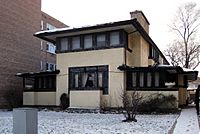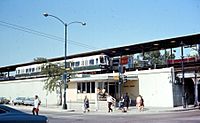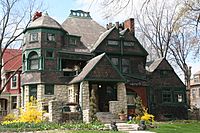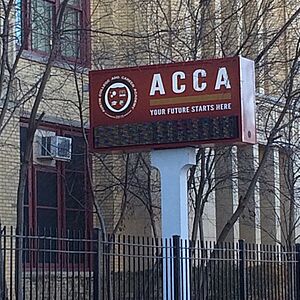Austin, Chicago facts for kids
Austin is one of the 77 community areas in Chicago, Illinois. It is located on the city's West Side. Austin is the third-largest community area by population and the second-largest in terms of land area. Its eastern border is near Cicero Avenue, its northern border is the Milwaukee District / West Line, and its southern border is Roosevelt Road. To the north, past North Avenue, Austin reaches Harlem Avenue, touching Elmwood Park. Austin also shares borders with the suburbs of Cicero and Oak Park.
Quick facts for kids
Austin
|
|
|---|---|
| Community Area 25 – Austin | |
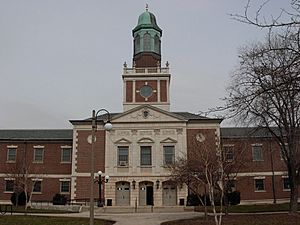
The Austin Town Hall Park field house.
|
|
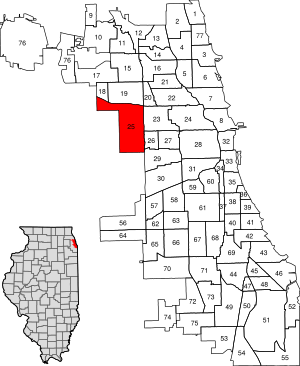
Location within the city of Chicago
|
|
| Country | United States |
| State | Illinois |
| County | Cook |
| City | Chicago |
| Neighborhoods | |
| Area | |
| • Total | 7.16 sq mi (18.54 km2) |
| Population
(2020)
|
|
| • Total | 100,120 |
| • Density | 13,986/sq mi (5,400.2/km2) |
| Demographics (2022) | |
| • White | 5.4% |
| • Black | 72.8% |
| • Hispanic | 19.4% |
| • Asian | 0.6% |
| • Other | 1.7% |
| Educational Attainment 2022 | |
| • High School Diploma or Higher | 82.3% |
| • Bachelor's Degree or Higher | 14.5% |
| Time zone | UTC-6 (CST) |
| • Summer (DST) | UTC-5 (CDT) |
| ZIP Codes |
60644 (entire)
60639, 60651, 60707 (partial) |
| Median household income (2022) | ,086 |
Contents
Austin's History
Early Development of Austin
The land where Austin now stands was first bought in 1835 by Henry DeKoven. Later, in 1857, a group of people created the Town of Cicero, which included the areas of modern-day Cicero, Oak Park, Berwyn, and Austin.
Eight years later, Henry W. Austin, a businessman, bought DeKoven's land. He then developed a new community called Austinville. The number of people living there grew very quickly. This was because the area had nice features and easy access to train services.
In 1870, the Town of Cicero placed its town hall in Austin. By the 1890s, Austin had a large population and played a big role in town decisions. However, the other parts of Cicero Township were not happy. In 1899, they voted to let Chicago take over the Austin area. The people of Austin voted against this, but the annexation still happened.
Austin's Growth and Changes
Even after joining Chicago, Austin kept its own suburban feel. By the 1920s, many streetcar lines were built to help people travel. This made the area attractive to many European immigrants. In 1926, it was thought that about 140,000 people lived in Austin.
In 1923, Austin Hospital opened. Later, in 1938, the Sisters of Saint Casimir took over the hospital. They renamed it Loretto Hospital. In 1949, construction started on the Eisenhower Expressway. This major road cut through the southern part of Austin.
After World War II, many African-Americans moved into nearby communities. By the mid-1960s, African-Americans also began moving into Austin. This led to some disagreements among the white residents. By 1970, about 32% of Austin's population was Black. Ten years later, this number grew to 73%. This change in population continued through the rest of the 1900s.
During this time, some services in the community also changed. The Central station on the Blue Line train closed in 1973. In 1988, St. Anne's Hospital closed, and the West Side Health Authority was formed. In 1991, the Sisters of Saint Casimir handed over control of Loretto Hospital to a management company.
Austin in the 21st Century
In 1999, plans were made to turn an old rail yard in Galewood into a new industrial park. This project brought new homes and a movie theater to the neighborhood.
Austin's Neighborhoods
Austin is Chicago's second-largest community area in both population and size. It is made up of four main neighborhoods: Galewood, The Island, North Austin, and South Austin.
Galewood Neighborhood
Galewood is named after Abram Gale, who bought a farm there in 1838. This neighborhood is bordered by the Milwaukee District / West Line to the north, Harlem Avenue to the west, North Avenue to the south, and Narragansett Avenue to the east.
Galewood has historically been home to many Italian-American families. It also has a good number of Chicago city workers. Since the 1980s, more African-American and Latino residents have moved in. This mix of cultures has happened peacefully in Galewood.
The neighborhood has two train stations on the Milwaukee District West Line. The Mars station mainly serves workers at the nearby Mars, Incorporated factory and Shriners Hospitals for Children. The Galewood Station offers regular train service.
Galewood is also closely connected to the neighboring Montclare community. They even share a library in the Chicago Public Library system.
The Island Neighborhood
The Island neighborhood is in the southwest part of Austin. It has about 1,700 residents and covers about one square mile. Its western and southern borders touch the suburbs of Oak Park and Cicero.
The Island is somewhat separated from the rest of Austin by an industrial area to its east and train tracks and Interstate 290 to the north. You can only get there from Austin Boulevard and Roosevelt Road.
The Island was the last of Austin's neighborhoods to become integrated. Today, it is a diverse community. The area, which used to be mainly industrial, now has a mix of businesses. Chicago Studio City, the largest film studio in the Midwest, is located here. Movies like Transformers: Dark of the Moon and The Dark Knight were partly filmed in The Island.
North Austin Neighborhood
North Austin is one of Austin's neighborhoods. Its northern borders are the Milwaukee District/West Line and Armitage Avenue. To the west, it's bordered by Austin Avenue or Austin Boulevard south of North Avenue. Its eastern border is Cicero Avenue, and its southern border is Division Street. The Robert LeFlore Jr. Post Office is located in this neighborhood.
South Austin Neighborhood
South Austin is the largest neighborhood in the Austin area. It is bordered by Division Street to the north, Austin Boulevard to the west, Roosevelt Road to the south, and Cicero Avenue to the east. This neighborhood was the first in Austin to become mostly African-American.
South Austin is known for its many historic buildings. It is home to several important landmarks listed on the National Register of Historic Places. These include the Austin Historic District, Midway Park, and Columbus Park. Austin Town Hall Park, which looks like Philadelphia's Independence Hall, is also in this neighborhood.
The neighborhood also has other Chicago landmarks not on the National Register. These include the Laramie State Bank Building and the F. R. Schock House.
Austin's Population
| Historical population | |||
|---|---|---|---|
| Census | Pop. | %± | |
| 1930 | 131,114 | — | |
| 1940 | 132,107 | 0.8% | |
| 1950 | 132,180 | 0.1% | |
| 1960 | 125,133 | −5.3% | |
| 1970 | 128,084 | 2.4% | |
| 1980 | 138,026 | 7.8% | |
| 1990 | 114,079 | −17.3% | |
| 2000 | 117,527 | 3.0% | |
| 2010 | 98,514 | −16.2% | |
| 2020 | 96,557 | −2.0% | |
In 2016, about 99,711 people lived in Austin, with 32,277 households. Most residents were African American (84.2%), with White (4.2%), Asian (0.5%), and other races making up the rest. About 10.3% of the population identified as Hispanic or Latino.
About 30.5% of the people were under 19 years old. The average age was 33.9 years. The typical household income in Austin was $31,435, which is lower than the city's average. Many residents earned less than $25,000 per year.
About 41,807 residents were working. Many worked in healthcare (18.9%), retail (11.3%), and administration (11%). The unemployment rate in Austin was 22.1%.
Austin's Economy
As of 2023, Austin does not have many grocery stores. Because of this, many people living in Austin travel to nearby suburbs to buy their groceries. To help with this, the Austin Town Hall City Market is held to provide more food options for the community.
Education in Austin
Austin Community Academy High School closed in 2007. It was replaced by smaller schools like Austin Business and Entrepreneurship Academy (opened 2006) and Austin Polytechnical Academy (opened 2007). Other parts of Austin are served by Manley High School, Marshall High School, and Orr Campus. Michele Clark Magnet High School is also in Austin.
K-8 Schools
- George Rogers Clark Elementary School
- DePriest Elementary School
- John Hay Elementary School
- Howe Elementary School
- Leland Elementary School
- Leslie Lewis Elementary School
- Joseph Lovett Elementary School
- Nash Elementary School
- Ronald E. McNair Elementary School
- Harriet E. Sayre Elementary School
- Spencer Elementary School
- Ella Flagg Young Elementary School
Former Public Schools
- Robert Emmet Elementary School closed in 2013. The building was later acquired to become a community service center.
Former Catholic Schools
The Roman Catholic Archdiocese of Chicago used to operate:
- Our Lady Help of Christians School (closed 1998)
- St. Peter Canisius School (closed 1990)
- San Miguel School Gary Comer Campus (opened 2002, closed 2012)
Chicago Public Library Branches
- Austin Branch: Opened in 1929 and named after Henry W. Austin.
- North Austin Branch: Opened in 1995.
- West Chicago Avenue Branch: Opened in 2006.
Media in Austin
Austin has three free weekly newspapers. The West Suburban Journal, started in 2004, is published by Trottie Publishing Group. The Austin Voice has been published since 1988. The Austin Weekly News, started in 2005, is published by The Wednesday Journal. Both papers are published on Wednesdays. Austin also has Austin Talks, an online publication run by journalism students from Columbia College Chicago.
Healthcare in Austin
St. Anne's Hospital, located in Austin, had space for 437 patients. It closed in September 1988. In 1997, it was announced that the building would be turned into apartments for older adults who needed affordable housing.
Notable People from Austin
Many well-known people have lived in Austin, including:
- William J.P. Banks, a former Alderman.
- Danny Boy, a hip-hop artist.
- Da Brat, a rapper and actress.
- Hannibal Buress, a stand-up comedian and actor.
- Ralph Capone, brother of Al Capone.
- Ike Carothers, a former Alderman.
- Crucial Conflict, a hip-hop group.
- Danny K. Davis, a member of the U.S. House of Representatives.
- Sam DeStefano, a member of the Chicago Outfit.
- La Shawn K. Ford, a member of the Illinois House of Representatives.
- Bud Freeman and the Austin High School Gang.
- Sam Giancana, a member of the Chicago Outfit.
- Andrew Greeley, a priest, sociologist, and novelist.
- John Marshall Hamilton, the 18th governor of Illinois.
- Steve Harris, an actor.
- Wood Harris, an actor.
- Brandon Johnson, the current mayor of Chicago.
- Roberta Karmel, the first female commissioner of the U.S. Securities and Exchange Commission.
- Camille Y. Lilly, a member of the Illinois House of Representatives.
- Emma Mitts, an Alderman.
- Pat Quinn, a former Governor of Illinois.
- Saba, a rapper and record producer.
- Robert Townsend, an actor and director.
- Lois Weisberg, a city official known for her social network.
- Erick Williams, a chef.
- Bobby Wilson, a former NFL player.
- Frank Peter Witek, a U.S. Marine and Medal of Honor awardee.
- Violet Bidwill Wolfner, an owner of the Chicago Cardinals football team.
- Abe Woodson, a former NFL player.
Images for kids




